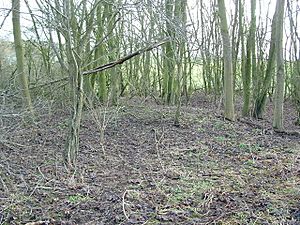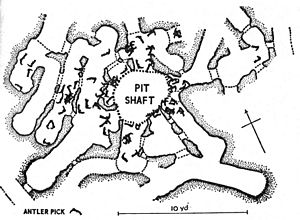William Greenwell facts for kids
Quick facts for kids
William Greenwell
|
|||||||||||
|---|---|---|---|---|---|---|---|---|---|---|---|
| Born | 23 March 1820 | ||||||||||
| Died | 27 January 1918 (aged 97) | ||||||||||
| Nationality | English | ||||||||||
| Known for | Archaeologist | ||||||||||
| Scientific career | |||||||||||
| Institutions |
|
||||||||||
|
|||||||||||
William Greenwell (born March 23, 1820 – died January 27, 1918) was an English archaeologist and a priest in the Church of England. He became famous for his important discoveries about ancient Britain.
Contents
Early Life and Education
William Greenwell was born on March 23, 1820, at Greenwell Ford, his family's estate near Lanchester, England. He was the oldest son of William Thomas Greenwell and Dorothy Smales. He had three brothers and a sister named Dorothy, who later became a poet.
From a young age, William was curious about history. His family's land included the site of an old Roman fort called Longovicium. He and his brother Frank loved to dig around the fort, which sparked his interest in archaeology.
William went to Durham School and then to University College, Durham. He first planned to become a lawyer, but due to poor health, he returned to Durham. He then studied theology and became a deacon in 1844 and a priest in 1846.
Discoveries in Archaeology


William Greenwell became a very important archaeologist. He was one of the first members of the Tyneside Naturalists' Field Club in 1846. He believed that archaeology should be a serious study, not just a hobby. He focused on gathering evidence from times before written records existed. This idea greatly influenced his student, Augustus Pitt Rivers, who became a pioneer in modern archaeology.
Greenwell did a lot of digging at important sites:
- In 1864, he excavated several ancient burial mounds, called barrows, at Danes Graves. This site belongs to the Arras Culture from the British Iron Age.
- In 1868, he explored an Anglian cemetery at Uncleby, finding 76 burials.
- He also worked at Grimes Graves, an ancient flint mine.
- He studied ancient electrum coins from Cyzicus and cataloged Bronze Age items found in Heathery Burn Cave.
William Greenwell collected many ancient items, especially from the Neolithic and Bronze Age periods in Britain. His huge collection is now kept at the British Museum. An American banker, J. P. Morgan, bought these items for a large sum of money and donated them to the museum. Greenwell also had a collection of Greek coins, which he sold to a collector who later gave them to the Boston Museum. His collection of carved stones is at the Durham Cathedral museum.
With the money he earned from selling his collections, Greenwell was able to buy back his family home, Greenwell Ford. He later left it to his nephew.
Life as a Canon
William Greenwell was a priest for most of his life. He served in several churches before becoming a canon at Durham Cathedral in 1854. He was known as Canon Greenwell. He also worked as a librarian at Durham Cathedral from 1863 to 1908, where he helped organize the many books and documents.
He was also involved in many historical societies:
- He was president of the Architectural and Archaeological Society of Durham.
- He was vice-president of the Society of Antiquaries of Newcastle.
- In 1868, he became a member of the Society of Antiquaries of London.
In 1870, he became a Justice of the Peace, helping to make legal decisions in his local area. He received the Medal of the Royal Numismatic Society in 1898 for his work with coins. He passed away on January 27, 1918, at the age of 97, and was buried in Lanchester.
Personal Interests
Known as 'The Canon' in Durham, William Greenwell was known for being direct and honest. He loved the outdoors and was an expert at fishing and hunting. He enjoyed these hobbies until he was very old. He even created a famous fishing fly called "Greenwell's Glory," which is still used today in fly fishing.
Works
- British Barrows, a Record of the Examination of Sepulchral Mounds in Various Parts of England (1877)
- The Electrum Coinage of Cyzicus (1887)
- Durham Cathedral: Catalogue of the Manuscripts in the Library of Durham Cathedral (1893)
See also
- List of archaeologists
- British Iron Age
- British Neolithic
- Grimes Graves
- Arras culture
- Danes Graves
- East Ayton Hoard
- Durham Cathedral


